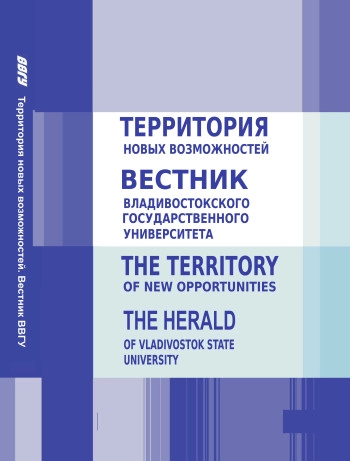Vladivostok, Russian Federation
The article provides details of Russian economic education in China in 1920–1945. Its necessity was conditioned by the expansion of international trade and the need to solve the CER economic problems, on the one hand, and by arriving in China a large number of refugees including economists from Russia, on the other hand. Their experience in teaching economic courses at Russian universities ensured the continuity of both the content of economic training and the overall policy of broad-based professional raining when the graduates were capable to solve economic problems in various fields of activity. Economic specialization was mainly implemented at the Law Faculty (Higher Economic and Legal Courses in 1920–1922) and the Institute of Oriental and Commercial Sciences (1925–1934) in Harbin, existing also at other higher schools. The article highlights regional features of Russian economic education, primarily the bias towards oriental studies, common for all Russian educational institutions in China at that time: compulsory oriental languages classes as well as courses on regional topics (history, geography, politics, economics, law of the Far Eastern countries). The authors provide information on the scientific interests and biographies of those who taught economic courses. The article is based on the publications of Russian press in China and archival documents. It is concluded that the organization of Russian economic education in China provides many positive examples that could be useful today in training specialists in economics at Russian universities, primarily the oriental component of the curricula and close educational contacts with neighbouring countries.
economic education, Russians in China, Harbin, Higher Economic and Legal Courses, Faculty of Law, Institute of Oriental and Commercial Sciences, Chinese Eastern Railway, CER Economic Bureau.
1. Kosinova O.A. Pedagogical traditions of the Russian diaspora in China at the end of the XIX – the first half of the XX centuries (1898–1945). Moscow: [b. and.]; 2008. 200 p.
2. Lazareva S.I., Shpileva A.N. Russian schools and universities in Manchuria in the 20–30 s. XX century. Russia and the Asia-Pacific region. 2011; (4): 10–20.
3. Khisamutdinov A.A. Russian higher education in China. Education issues. 2015; (4): 274–291.
4. Meshcheryakov A.Yu., Antropov O.K. Harbin Polytechnic Institute in 1920–1976. Manuscript. 2019; (6): 68–72.
5. Dorofeeva M.A. Research and publishing activities of the Economic Bureau of the CER in Northern Manchuria. Russia and China: history and prospects of cooperation: mater. III International. scientific-practical. conf. (Blagoveshchensk-Heihe-Harbin, May 15–20, 2013). No. 3. Blagoveshchensk; 2013: 38–43.
6. Samoilov N.A. Historical heritage of the CER and the formation of the image of Russia in the North-East of China. Scientific notes of Petrozavodsk State University. 2018; 2 (171): 88–94.
7. Ornantskaya T.A. Activities of the Faculty of Law in Harbin in 1920-1937. Law and Education. 2016; (4): 148–156.
8. Dorofeeva M.A. Faculty of Law in Harbin as an outpost of Russian education in China. Shores: Information and Analytical Collection on Russian Abroad. 2008; (9). St. Petersburg: ICC "Russian Emigration". P. 40–46.
9. Chi Yuchao, Khisamutdinov A.A. First alma mater of lawyers: from Vladivostok to Harbin. Vladivostok: Publishing House Dalnev. feder. un-ta; 2023. 430 p.
10. Serebrennikov I.I. My memories. T. II. In exile (1920–1924). Tianjin: Our Knowledge; 1940. 260 p.
11. O.R.S.M. Harbin School of Law: Type. "Dawn"; 1935. 27 p.
12. Molotnikov A.E. Preface//Selected works of the Faculty of Law in Harbin. Moscow: RCSO; 2017. P. 5–7.
13. Mirolyubov N.I. Faculty of Law in Harbin. Izvestia and the works of the Russian-Chinese Polytechnic Institute; High School in Harbin. No. 2, no. 1 (1922–1923). Harbin; 1923. P. XXXVII–XL.
14. Avtonomov N.P. Faculty of Law in Harbin: historical essay. Law and Culture: Sat. to commemorate the eighteen-year existence of the Faculty of Law in the city of Harbin. 1920–1937. Harbin: Russian-Manchu bookselling; 1938. P. 3–86.
15. Faculty of Law in Harbin (Historical Note). Proceedings of the Faculty of Law; High School in Harbin. Harbin; 1925. T. I. P. 201–213.
16. Dudin P.N. Educational process at the Faculty of Law of Harbin. Bulletin of the Buryat Scientific Center of the Siberian Branch of the Russian Academy of Sciences. 2015; 3 (19): 148–154.
17. G.K. Institute of Oriental and Commercial Sciences. Polytechnic. Australia. 1979; (10). P. A. 2-7.
18. Faculty. Bulletin of Asia. 1926; (53): 410–411.
19. And [vashkevi] h. Writers, scientists and journalists in the Far East for 1918–1922 Vladivostok: [b. and.]; 1922. 72 p.
20. "Vif". Review. Free Siberia. Prague. 1927; (1): 205, 206.
21. Bakich O.M. Harbin Russian imprints: bibliography as history, 1898–1961: Materials for a definitive bibliogr. New York: Ross; 2002. XX. 584 p.: il.
22. Nikiforov N.I. Oasis of Russian culture. Frontier. 1934; (34). 18 August: 17–21.
23. Iogel I. North Manchurian University graduated about 150 emigrants – valuable specialists. Rubezh. 1941; 41/4 (Oct. 11): 7–9: phot.
24. Ray of Asia. Harbin; 1938. № 48/8.





